| | Aphid | Mite | Crown borers | Fruit worm| Raspberry sawfly | Wasps/hornets/yellow jackets
An important part in the production of any fruit crop is to know what type of insects could cause production losses. A crop is at risk throughout the fruiting cycle. Insects can attack plants during flowering, fruit formation or just before harvest of the plump, juicy berries. A successful pest management program includes: insect identification; pest number and damage monitoring; what population numbers warrant control and knowing when the pest can be effectively controlled.
Aphid
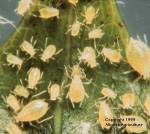
Green Peach Aphids
Identification
- 1-3 mm long, soft-bodied, pear-shaped
- main identifying feature: cornicles (tail pipes protruding out of the back end)
- variety of colors: green, yellow, pink, white, bronze, dark-brown or black
- adults may be winged or wingless
Life cycle
- overwinters as eggs on the host plant
- eggs hatch into "stem" mothers which bear live young; these live young, in turn, bear more live young
- each mature aphid can produce 50-100 offspring
- 15-30 generations may be produced per season
- they can reproduce either sexually or asexually (parthenogenesis - being able to reproduce from eggs which have not been fertilized)
- males are not produced until fall
- mating occurs in the fall
- either an egg is produced; or, another stem mother, which lays the overwintering eggs
Damage
- symptoms of feeding damage are leaf discoloration, a flattened appearance and ,in severe cases, wilted plants
- when aphids feed, they puncture plant capillaries; the plant then pumps the sap into the aphid; exudate (excess sap) comes out the back end of the aphid
- this exudate is called honey dew
- honey dew makes the leaves and fruit sticky
- honey dew can also be a nutrition source for the growth of sooty mold fungi (not harmful to the plant, but it can make the fruit unsalable)
- aphids seldom cause much direct injury, unless present in large numbers
- they may transmit viral diseases
Monitoring
- generally, they are found in clusters on the new growth, stems, buds or on the underside of leaves among the veins
- look for symptoms weekly
- consider the weather conditions, presence and abundance of natural enemies, and the value and stage of the crop before spraying
Cultural control
- start with clean stock
- there are a wide range of natural predators: lady bugs, lace wings, and predatory wasps
Mite
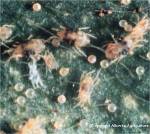
Identification
- .5 mm, oval, greenish-yellow with 2 irregular dark spots on the back
Life cycle
- overwinters as an egg, a nymph or an adult on old leaves on the ground or in
- cracks and crevices of old canes
- when the plant starts to grow, the mites mate and lay eggs on the leaf underside
- eggs hatch and begin to feed
- there can be several generations overlapping
- hot, dry weather favors population explosions
|
|
Damage
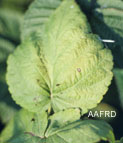
Spider mite damage
- feeds on the leaf underside
- feeding damage causes yellow spots (mottling or stippling) changing to silver or bronze, then brown with leaf crinkling and curling
- leaves may dry up and fall prematurely
- high populations will cause loss of plant vigor
- feeding on primocanes stunts cane growth, therefore, reducing crop potential for the following season
- dusty conditions will create a larger mite population, causing more problems
- injury can be worse after harvest
Monitoring
- examine for webbing between or under the leaflets
- webbing indicates a very heavy infestation
- damage is most noticeable in dry areas of the field
- diagnostic tools: breathe on leaflets, this causes the mites to scurry about, or tap the leaf over a white sheet of paper to make the pest visible
- check the canopy top of the fruiting canes
Cultural control
- spider mite predators become established as plants mature
- irrigate regularly to avoid water stress on plants
- eliminate weeds that can be used as alternate hosts
Chemical control
- begin the chemical control when mites first appear and repeat as necessary
- ensure leaf undersides are well covered with insecticide
Crown Borers
Identification
- the adult is a clear-winged moth, 25-30 mm long
- the abdomen is black with yellow bands and stripes on the thorax
- new larvae are 3 mm long, whitish with brown heads
- mature larvae are 25 mm long with white bodies and brown heads
- larvae have six short legs
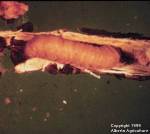
Raspberry crown borer mature larva
Life cycle
- adults appear in August or September females lay 130-150 eggs on the leaf undersides (2-3 per plant)
- eggs hatch in September and October, larvae crawl down the cane to the base
- overwinters in tiny blisters on cane just below soil surface
- larvae emerge the following spring and feed on primocanes through the summer
- by October, the larvae are nearly full grown and spend the winter in the feeding burrows
- they burrow further into the crown to feed the following summer
- in July, they tunnel and pupate a few centimetres near the outside of the cane
- it takes 2 years to complete the life cycle
|
Damage
- slows cane growth with the possibility of cane death
- reduced yields
- new canes are girdled near the ground
- canes become spindly and are easily broken
- may also form galls
Monitoring
- dig the crown out, look for holes and sawdust
Cultural control
- after harvest, prune out loose canes and ones with galls
- during the summer, remove and destroy wilting canes
|
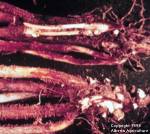
Raspberry canes damaged by crown borer
Fruit Worm
Identification
- the adult is a small brown beetle, 4 mm
- the larva is small (6 mm) and whitish-brown
Life cycle
- adults lay eggs in early spring on or near the developing blossom clusters and green berries
- larvae feed in the berry and may be in the fruit at harvest
- mature larvae drop to the ground and pupate
- overwinters as an adult
Damage
- presence of yellowish larva on the harvested fruit, making the fruit unsalable
- adults feed on leaves before they unfold, so leaves have a tattered appearance
Chemical control
- spray when blossom bud clusters separate and just before blossom opening
Raspberry Sawfly
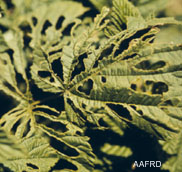
Sawfly damage
Identification
- the adult sawfly is 5.5 mm long, black with yellowish-red markings
- the larva is 12 mm long, light green in color, all body segments, except the head, possess a number of whitish bristles
Life cycle
- adults emerge in the spring (blossom time)
- they lay eggs in the leaf tissue
- larvae feed during the summer
- the larvae drop to the ground, construct a cocoon and overwinters as larvae
- they pupate in the spring
Damage
- they feed on leaf underside, flower buds, young fruit and tender bark of growing shoots
- initial damage appears as small holes in leaves
- they will completely devour the leaves leaving elongated holes between the larger veins
- the feeding results in weak plants
Monitoring
- during July, watch for holes in the leaves
Chemical control
- often controlled when spraying for other pests
|
Wasps/Hornets/Yellow Jackets
Identification
- some adult paper wasps are black with yellowish-white markings; others are black with bright yellow markings
- a colony consists of workers (sterile females), drones (males) and the queen
- only females have the stinger
- wasps are hunters and are useful in controlling caterpillars and flies, but they can become pests in the berry fields
Life cycle
- warm, dry springs produce larger wasp problems in August than do wet, cool springs
- in spring, the fertilized queen emerges from hibernation
- she chooses a good spot (a hole in the ground, such as a mouse burrow, a tree branch, bush, under the eaves or in the walls of a building) and begins to build a nest by chewing wood fibers into a pulpy mass
- the queen lays eggs which hatch into legless, blind larvae
- larvae last 2 weeks, then pupate
- in 3 weeks, adult females emerge and begin to tend the queen
- in August, male and new queen cells are produced
- in early fall, the males and new queens emerge, mating takes place on the wing
- males die and fertilized queens overwinter in protected sites like stumps or hollow logs
- the nest is abandoned and never used again
Damage
- wasps are attracted to the ripe or injured fruit as a source of sugar and moisture
- dangerous to pickers as the sting is painful and ,in some cases, may cause an allergic reaction which could lead to death
Cultural control
- prompt harvesting of ripe berries and clean picking practices
- hang a piece of meat or fish over a bucket of water with detergent in it; wasps will take a mouthful and fall into the water and drown
- 2 litre soda pop bottle with about 5 cm of soda pop left in the bottom attracts wasps into bottle
- basin or some other shallow container, with a few inches of water in it, add syrup (like maple); the insect is drawn to the syrup and drowns in the water
- set nest on fire with a torch
- knock nest into a sack and burn it
- carry out control methods after dusk, after the wasps have settled for the night
- wear protective clothes (coveralls, gloves hat netting with ends tucked into the collar) when dealing with wasps
- if necessary to use a flash light, don't hold the flashlight, set it aside to shine on the nest
- some of the insects will become agitated, leave the nest angry and go for the light, possibly attacking it
Chemical control
- spray insecticide into the entrance of the nest, do this after dark
- for ground nests, stuff insecticide soaked cotton or steel wool into the nest
|
|